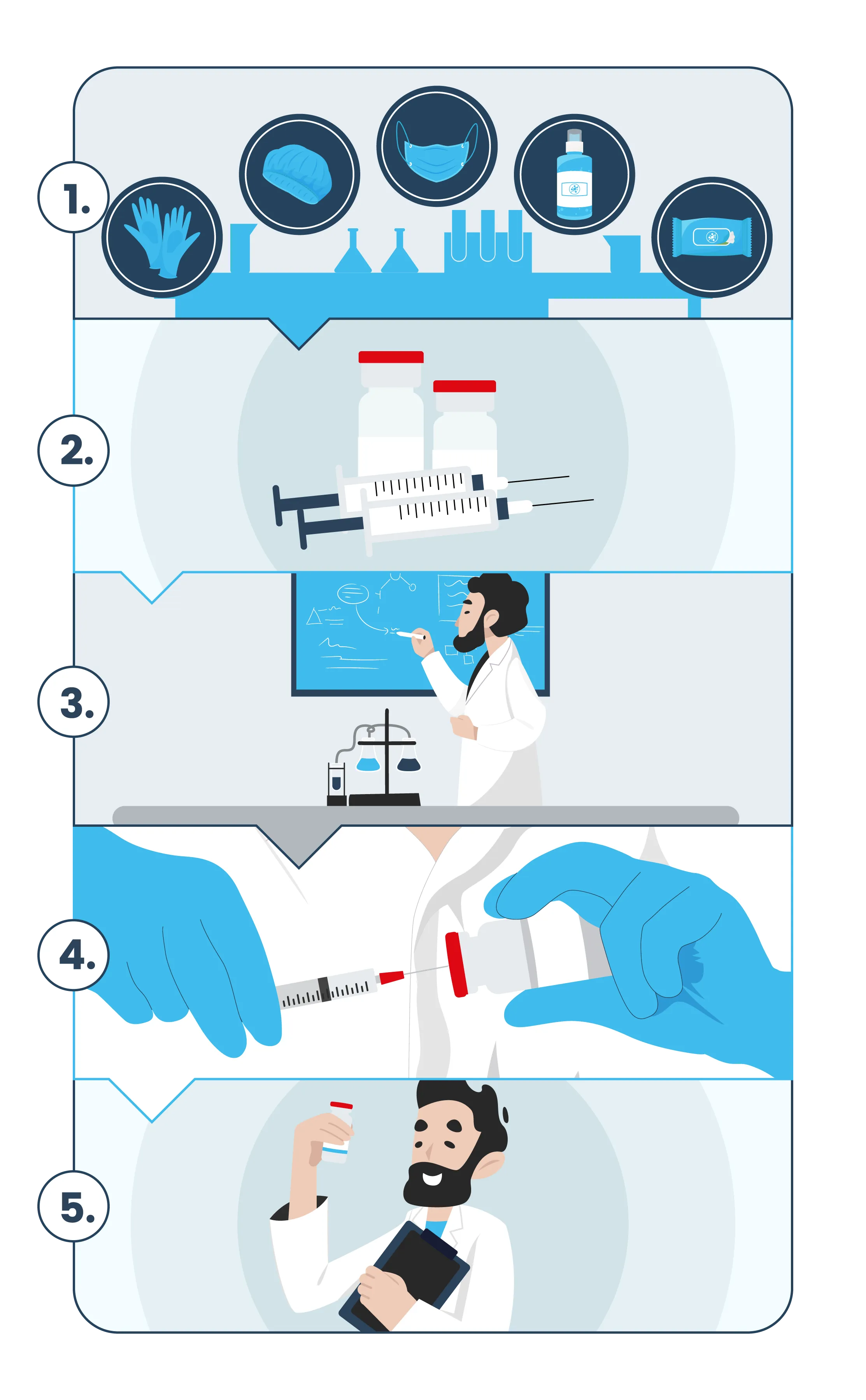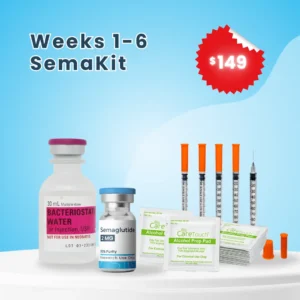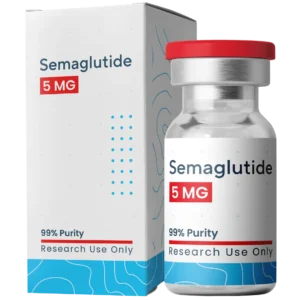Uncover the rubber stopper by removing the plastic cap from the semaglutide vial
This table outlines the recommended dosage increase schedule for semaglutide, based on clinical studies. It’s designed to help your body gradually adjust to the medication while minimizing potential side effects.
| Weeks | Weekly dose for weight loss | |
|---|---|---|
| Dose escalation | Week 1-4 (month 1) | 0.25 mg |
| Week 5-8 (month 2) | 0.5 mg | |
| Week 9-12 (month 3) | 1 mg | |
| Week 13-16 (month 4) | 1.7 mg | |
| Maintenance dose | Week 17 and onward (month 5+) | 2.4 mg |
Not everyone needs to increase their dose—some people respond well at lower levels and can stay there comfortably. The escalation is recommended, but it’s always up to you and how your body feels. If you reach a weight loss plateau, that may be a good time to increase your dose. If you experience side effects or discomfort, it’s okay to delay dose escalation or temporarily reduce your dose.
Our semaglutide is supplied in powder form, which means it needs to be mixed with bacteriostatic water before use. To make the process simple and stress-free, we’ve created detailed step-by-step PDF guides for each kit we offer.
These guides include:
Whether you’re just starting or continuing your journey, download the guide for your kit below to ensure safe and effective use.
StarterKit Guides (For Beginners):
This guide is for the 2 mg vial only
This guide is for the 5 mg vial only
This guide is for the 2 mg vial → 5 mg vial only
Continuation Kit Guides:
5 mg vial doses guide:
Tirzepatide Guide:
New here? Not sure which kit is right for you?
Explore how each plan works and find the one that fits your goals.
For the 2 mg vial, you can use either 1 mL or 2 mL of water. With smaller doses, 2 mL of water is easier to measure, and with larger doses, 1 mL would be more convenient.
The second and third columns of the chart below tell you how much solution to draw into the syringe so that it contains the desired dose.
Swipe right to see the full chart →
| If added 1 mL of bacteriostatic water, draw: | If added 2 mL of bacteriostatic water, draw: | |
|---|---|---|
| 0.25 mg dose (8 doses in one vial) | 12.5 units (0.125 mL) | 25 units (0.25 mL) |
| 0.5 mg dose (4 doses in one vial) | 25 units (0.25 mL) | 50 units (0.5 mL) |
| 1 mg dose (2 doses in one vial) | 50 units (0.5 mL) | Not recommended for the dose of 1 mg as a large volume of liquid (1 mL/100 units) can be uncomfortable to inject. |
| 1.7 mg dose (1 dose in one vial) | 85 units (0.85 mL) | Not recommended for the dose of 1.7 mg (170 units/1.7 mL) as this would exceed the 1 mL syringe capacity, so it's better to stick with 1 mL of water for this dose. |
Use this guide if you’re just beginning your semaglutide journey. It provides detailed instructions for mixing and injecting your 2 mg semaglutide vial, starting with the lowest dose of 0.25 mg per week and following a dosage escalation schedule over the first 6 weeks.
For the 5 mg vial, 2 mL of water is generally more convenient for drawing up doses and keeps injection volumes low. However, 1 mL is also possible.
The second and third columns of the chart below tell you how much solution to draw into the syringe to achieve the desired dose.
Swipe right to see the full chart →
| If added 1 mL of bacteriostatic water, draw: | If added 2 mL of bacteriostatic water, draw: | |
|---|---|---|
| 0.25 mg dose (20 doses in one vial) | Not recommended for the dose of 0.25 mg as drawing can be difficult due to the very small volume of liquid involved (0.05 mL/5 units). | 10 units (0.1 mL) |
| 0.5 mg dose (10 doses in one vial) | 10 units (0.1 mL) | 20 units (0.2 mL) |
| 1 mg dose (5 doses in one vial) | 20 units (0.2 mL) | 40 units (0.4 mL) |
| 1.7 mg dose (3 doses in one vial) | 34 units (0.34 mL) | 68 units (0.68 mL) |
| 2.4 mg dose (2 doses in one vial) | 48 units (0.48 mL) | Not recommended for the dose of 2.4 mg as a large volume of liquid (0.96 mL/96 units) can be uncomfortable to inject. |
Use this guide if you’re just beginning your semaglutide journey. It provides detailed instructions for mixing and injecting your 5 mg semaglutide vial, starting with the lowest dose of 0.25 mg per week and following a dosage escalation schedule over the first 10 weeks.
If you place an order, you will receive personalized instructions in your email. Please follow the instructions in your email.
Below you will find a brief overview of the instructions for general reference.
Semaglutide comes in a powder form and needs to be mixed or “reconstituted” with bacteriostatic water before use.
Bacteriostatic water is a liquid for injections that contain 0.9% benzyl alcohol as an antimicrobial preservative.
Below are the instructions on how to mix semaglutide correctly.
Uncover the rubber stopper by removing the plastic cap from the semaglutide vial
Uncover the rubber stopper by removing the plastic cap from the bacteriostatic water vial
Safeguard against bacterial contamination by swabbing the rubber stoppers with alcohol pads
Insert the needle of the syringe into the rubber stopper of the bacteriostatic water vial
Withdraw the desired amount of bacteriostatic water from the vial by slowly pulling back the plunger to the corresponding mark on the syringe
Once the bacteriostatic water is in the syringe, remove the needle from the vial of the bacteriostatic water and insert it into the rubber stopper of the semaglutide vial
Add bacteriostatic water into the semaglutide vial gradually by injecting
Swirl the solution gently until complete dissolution of the peptide. Avoid shaking the vial
Store peptides reconstituted with solvent in the refrigerator, typically at temperatures ranging from 2°C to 8°C.
Consider dividing the reconstituted semaglutide solution into smaller aliquots. This reduces the risk of degradation.
Clearly label the containers with the date of reconstitution and the concentration of the solution. This helps in tracking the age and potency of the solution.
Do not freeze semaglutide reconstituted semaglutide as this will cause the product to lose its properties and effectiveness.
Have questions about semaglutide?
Go to our Semaglutide FAQ to learn more, or contact us.
*Please do not use the following dosing instructions if you use semaglutide vials from another supplier. Contact your supplier for the appropriate instructions, as these can vary depending on the vial.
To create a solution for injection, you can add up to 2 mL of bacteriostatic water into your semaglutide vial. We do not recommend adding more than 2 mL.
Below is a breakdown of how to dose semaglutide and how many doses you can get from each vial.


Sign up to be the first to know about new products, discounts and promotions.
While we make a reasonable effort to ensure the quality, accuracy, and safety of the content on our website, it is important to state that it is provided for general information purposes only and does not constitute medical advice. The content on this website, including text, images, and other content, is not intended to replace a consultation with an appropriately qualified medical practitioner.
SEMA.bio does not provide medical advice. Always consult your healthcare provider about possible interactions, contraindications, and allergies before starting any new supplement or medication.
Individual weight loss results may vary.
Products offered on this website are not approved by the U.S. Food and Drug Administration (FDA). These products are not intended to diagnose, treat, cure, or prevent any disease. Any improper use, including but not limited to the unauthorized handling, storage, or administration of these products, is the sole responsibility of the purchaser. This website and its product offerings are not associated, connected with or endorsed by Nоvо Nоrdіsk A/S in any manner.

